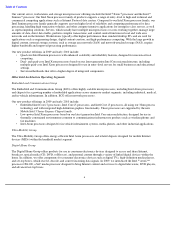Intel 2009 Annual Report Download - page 20
Download and view the complete annual report
Please find page 20 of the 2009 Intel annual report below. You can navigate through the pages in the report by either clicking on the pages listed below, or by using the keyword search tool below to find specific information within the annual report.
Table of Contents
Fluctuations in demand for our products may harm our financial results and are difficult to forecast.
If demand for our products fluctuates as a result of economic conditions or for other reasons, our revenue and profitability
could be harmed. Important factors that could cause demand for our products to fluctuate include:
If product demand decreases, our manufacturing or assembly and test capacity could be underutilized, and we may be required
to record an impairment on our long-lived assets, including facilities and equipment as well as intangible assets, which would
increase our expenses. In addition, if product demand decreases or we fail to forecast demand accurately, we could be required
to write off inventory or record underutilization charges, which would have a negative impact on our gross margin. Factory-
planning decisions may shorten the useful lives of long-lived assets, including facilities and equipment, and cause us to
accelerate depreciation. In the long term, if product demand increases, we may not be able to add manufacturing or assembly
and test capacity fast enough to meet market demand. These changes in demand for our products, and changes in our
customers’
product needs, could have a variety of negative effects on our competitive position and our financial results, and, in
certain cases, may reduce our revenue, increase our costs, lower our gross margin percentage, or require us to recognize
impairments of our assets.
Litigation or regulatory proceedings could harm our business.
We may be subject to legal claims or regulatory matters involving stockholder, consumer, competition, and other issues on a
global basis. As described in “Note 28: Contingencies” in Part II, Item 8 of this Form 10-K, we are currently engaged in a
number of litigation and regulatory matters, particularly with respect to competition. Litigation and regulatory proceedings are
subject to inherent uncertainties, and unfavorable rulings could occur. An unfavorable ruling could include monetary damages
or, in cases for which injunctive relief is sought, an injunction prohibiting us from manufacturing or selling one or more
products, precluding particular business practices, or requiring other remedies, such as compulsory licensing of intellectual
property. If we were to receive an unfavorable ruling in a matter, our business and results of operations could be materially
harmed.
The semiconductor industry and our operations are characterized by a high percentage of costs that are fixed or difficult to
reduce in the short term, and by product demand that is highly variable and subject to significant downturns that may
harm our business, results of operations, and financial condition.
The semiconductor industry and our operations are characterized by high costs, such as those related to facility construction
and equipment, R&D, and employment and training of a highly skilled workforce, that are either fixed or difficult to reduce in
the short term. At the same time, demand for our products is highly variable and there have been downturns, often in
connection with maturing product cycles as well as downturns in general economic market conditions. These downturns have
been characterized by reduced product demand, manufacturing overcapacity and resulting underutilization charges, high
inventory levels, and lower average selling prices. The combination of these factors may cause our revenue, gross margin,
cash flow, and profitability to vary significantly in both the short and long term.
15
ITEM 1A.
RISK FACTORS
• changes in business and economic conditions, including downturns in the semiconductor industry and/or the overall
economy;
• changes in consumer confidence caused by changes in market conditions, including changes in the credit market,
expectations for inflation, and energy prices;
•
changes in the level of customers
’
components inventories;
• competitive pressures, including pricing pressures, from companies that have competing products, chip architectures,
manufacturing technologies, and marketing programs;
•
changes in customer product needs;
•
strategic actions taken by our competitors; and
•
market acceptance of our products.
























